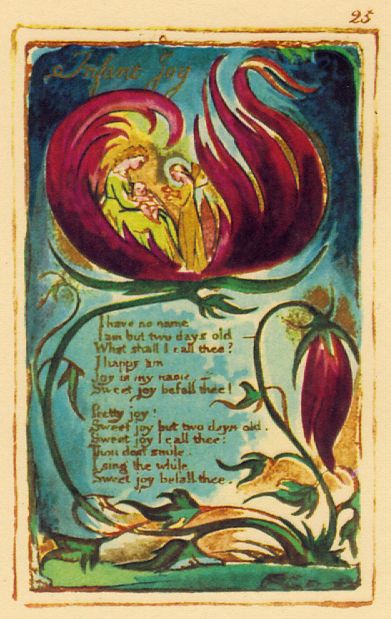Today marks the anniversary of the birth of William Blake, so this week’s picture-cum-poem is Infant Joy from his hand-coloured illustrated book, The Songs of Innocence. Its theme, appropriate to the poet’s birthday, is the advent of a newborn child into the world: “I have no name, / I am but two days old. / What shall I call thee? / I happy am / Joy is my name, / Sweet joy befall thee! / Pretty joy / Sweet joy but two days old, / Sweet joy I call thee; / Thous dost smile / I sing the while / Sweet joy befall thee.”
The words of Blake’s poem are written in a cursive script that has an unusually organic and almost vegetal character, the many curling “y”s of the incantatorily repeated word “joy”, in particular, resembling the tendrils of a plant. The poem seems in this way to sprout its own illustration, image appearing as a natural outgrowth of text and thereby literally embodying Blake’s belief that the poet is also a visionary. The vivid and highly stylised flowering plant that curls around the body of the poem’s text issues in two blooms, one furled, one open, resembling tulips but also flames, long associated with visionary experience in mystical literature. The fiery blossom at the top contains a scene of nativity, with a mother and child being watched over by a slender angel with the diaphanous wings of a butterfly. The innocent, whose name is Joy, seems to acknowledge the presence of the angel. This implies that the child is blessed with the capacity to see those who walk in the spiritual realm. Blake told his friends that he too often conversed with angels.
Blake’s first edition of The Songs of Innocence appeared in 1789, when he...

ITP 239: Infant Joy by William Blake
28-11-2004

